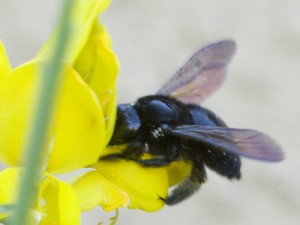Africanized Honey Bee
The Africanized honey bee is also known by many as the “killer bee.” It is present in Northern Arizona and it’s here to stay. As far as foraging for pollen this bee really isn’t any more dangerous than the European Honey bee. When you have a hive of these guys is when the trouble starts. They are very aggressive and will try relentlessly to protect their hive. Do not try to remove them yourself, get help from a professional bee hive removal service.
For more information, see these publications from the University of Arizona College of Agriculture
- They are called Africanized Honey Bees
- Africanized Honey Bees: How to Bee-Proof Your Home
- Africanized Honey Bees Outdoor Recreation Safety Tips
- Africanized Honey Bees and Your Pets and Livestock
European Honey Bee

The European honey bee is our traditional honey bee. if not provoked these bees are generally pretty docile. In a hive situation these bees will also become very protective if provoked, but they are just not as aggressive as the Africanized honey bee.
Honey Bee Swarm
Swarming is the natural means of reproduction of honey bee colonies. A new honey bee colony is formed when the queen bee leaves the colony with a large group of worker bees, a process called swarming.

Swarming is mainly a spring phenomenon, but occasional swarms can happen throughout the producing season.
Encountering a bee swarm for the first time can be frigtening. But the bees are usually not aggressive at this stage of their life cycle. They’re mostly interested in finding a new nest location for their queen. They will attack if they perceive a threat. While looking for a nesting place, a swarm cluster will form hanging from a tree branch. The swarm will move on in a day or two to find a suitable nesting location.
Bee swarms can be exterminated, but this is rarely necessary as they will either move on in a couple of days, or they can be collected by a beekeeper.
Bumble Bee
Bumblebees are bigger than honey bees and have black and yellow body hairs, often in bands.
Queen and worker bumblebees can sting, but unlike a honey bee’s, a bumblebee’s stinger lacks barbs, so they can sting more than once. Bumblebee species are normally non-aggressive, but will sting in defense of their nest or if harmed.
Bumblebees form colonies. These colonies are usually much less extensive than those of honey bees. Often, mature bumblebee nests will hold fewer than 50 individuals. Bumblebee nests may be found within tunnels in the ground made by other animals, or in tussock grass.
Carpenter Bee

Homeowners often confuse bumblebees and carpenter bees when they see large, black bees hovering in the air near wooden buildings. These most likely are not bumblebees but male carpenter bees. Male carpenter bees do not have stingers but will act a little aggressive if provoked. The female that does have a stinger is usually pretty docile. These Bees make their homes in wood around homes that is not treated or weather sealed. They can affect the structural integrity of wood if they have been boring in the wood for a long period of time. If you suspect that you have carpenter bees getting into wood around your structure, call us for a treatment plan to take care of them.
Bee Hive Removal
Arizona Bug Company provides bee hive removal services. See our pest control discounts page for a coupon on a free estimate for bee hive removal.
